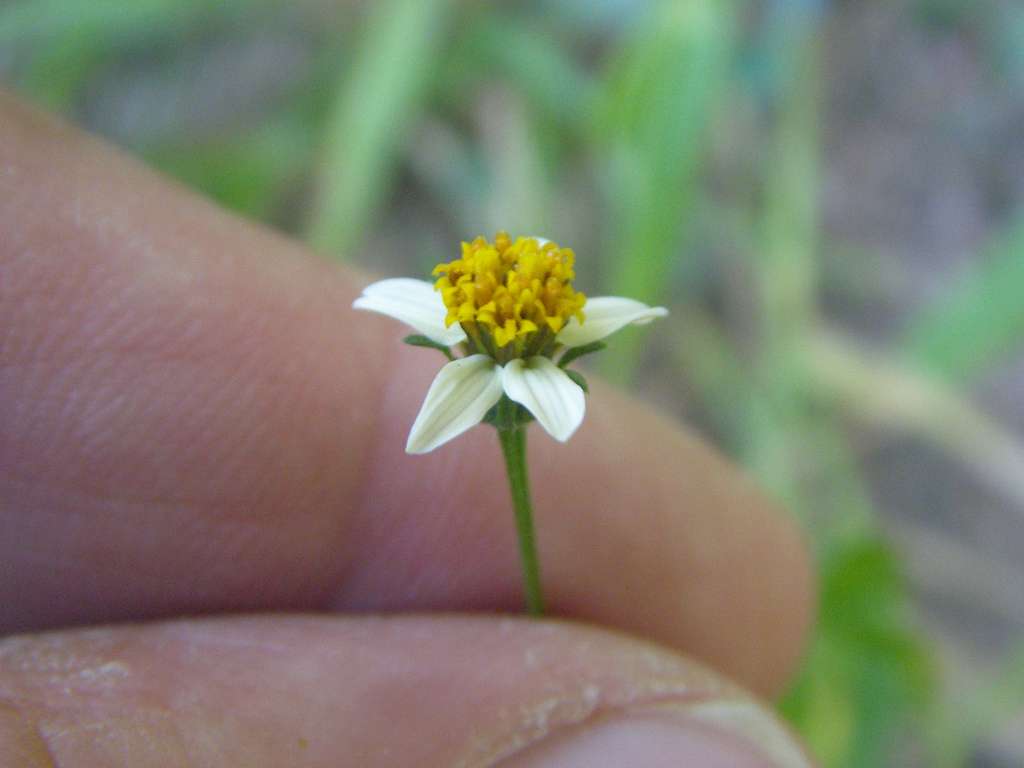Bidens
|
Family: Asteraceae |
Annuals or perennials [shrubs, vines], 5-400 cm. Stems usually 1, usually erect, (terete or 4-angled, often striate or sulcate) branched distally or ± throughout. Leaves usually cauline; usually opposite, rarely whorled, distal sometimes alternate; petiolate or sessile; blades simple, compound (leaflets petiolulate), or 1-3+-pinnatisect or -pinnately lobed (submerged leaves multifid in B. beckii, an aquatic), ultimate margins entire, dentate, laciniate, serrate, or toothed, faces usually glabrous, sometimes hirtellous, hispidulous, pilosulous, puberulent, scabrellous, or strigillose. Heads usually radiate or discoid, sometimes ± disciform, usually in corymbiform arrays, sometimes in 2s or 3s or borne singly. Calyculi of (3-)5-13(-21+) erect to spreading or reflexed, ± herbaceous (sometimes foliaceous) bractlets or bracts (sometimes surpassing phyllaries). Involucres mostly hemispheric or campanulate to cylindric, (1-)4-12(-25+) mm diam. Phyllaries persistent, mostly (4-)8-21(-30+) in ± 2 series, usually distinct, sometimes connate 0.05-0.1 their lengths, mostly oblong or ovate to lance-oblong, chartaceous to membranous or scarious (usually striate with brownish nerves, margins usually hyaline). Receptacles flat or slightly convex, paleate; paleae usually falling, (usually stramineous, sometimes yellow to orange, with darker striae) ± flat to slightly navicular. Ray florets usually 1-21+ (often 3, 5, 8, or 13), sometimes 0, usually neuter, sometimes styliferous and sterile; corollas usually yellow, sometimes white or pinkish. Disc florets (5-)12-60(-150+), bisexual, fertile; corollas usually yellow to orange, sometimes whitish [purplish], tubes shorter than throats, lobes (3-)5, ± deltate (staminal filaments glabrous; style-branch appendages deltate or lanceolate to subulate). Cypselae usually obcompressed to flat, unequally 3-4-angled, and cuneate to oblanceolate or obovate, sometimes (all or inner) ± equally 4-angled and linear-fusiform, rarely subterete, margins (± corky-winged in B. aristosa, B. cernua, and B. polylepis) usually retrorsely, sometimes patently or antrorsely, barbed or ciliate, apices sometimes attenuate, not beaked [beaked], faces smooth, striate, or ± tuberculate, glabrous or hairy, each sometimes with 2 grooves; pappi 0, or persistent, of (1-)2-4(-8) usually retrorsely, sometimes antrorsely, barbellate or ciliate, rarely smooth, awn Within species of Bidens, leaves may be simple, 1-pinnately compound, or 1-3-pinnatisect or -pinnately or -ternately lobed. For compound leaves, leaflets are described; for leaves mostly 1-pinnately lobed, primary lobes are described; for leaves 2-3-pinnatisect or -pinnately lobed, the ultimate lobes are described. Involucres in Bidens species are subtended by more or less herbaceous (sometimes foliaceous) bractlets or bracts; collectively, they constitute calyculi and they often well surpass the phyllaries. Together, phyllaries constitute involucres. In keys and descriptions here, shapes, heights, and diameters given for involucres are for involucres at flowering; involucres are sometimes notably larger in fruit. In some Bidens species, the outer and inner cypselae are obcompressed (unequally 3-4-angled) to flat, are mostly cuneate to obovate or nearly linear (broadest at or near apices), and are more or less similar except for sizes (outer smaller); in other species, the outer cypselae are obcompressed to flat and obovate to cuneate or linear and the inner are more or less equally 4-angled (in cross section) and linear-fusiform (thickest near their middles and more or less attenuate toward their tips).
Heads radiate or discoid, the rays when present few, often 8, sterile, generally neutral, yellow or less often white or pink; invol bracts biseriate and dimorphic, the outer ±herbaceous, often very large, the inner membranous, often striate; receptacle flat or slightly convex, its bracts narrow, flat or nearly so; disk-fls perfect and fertile; style-branches flattened, with externally hairy, usually short appendage; achenes flattened parallel to the invol bracts, but not (or scarcely) winged, or sometimes almost regularly tetragonal, rarely subterete; pappus of (1)2-4(6) awns or teeth, commonly retrorsely barbed, but sometimes antrorsely barbed or even barbless, in a few spp. obsolete; herbs (ours) with opposite, simple to dissected lvs. 200, cosmop.
Thelesperma megapotamicum (Spreng.) Kuntze, of the Great Plains, has been reported as adventive in Ill. and Mo. It is a glabrous perennial with the lvs once or twice pinnatifid into slender segments; the discoid (or inconspicuously radiate) heads terminate long, naked peduncles; the outer invol bracts are very short, and the inner ones are connate to the middle or above; the wingless achenes have a pappus of 2 retrorsely barbed awn-scales. (T. gracile) Gleason, Henry A. & Cronquist, Arthur J. 1991. Manual of vascular plants of northeastern United States and adjacent Canada. lxxv + 910 pp. ©The New York Botanical Garden. All rights reserved. Used by permission. |

